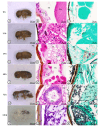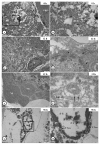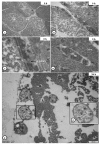Histopathological Study of Host-Pathogen Interactions Between Cordyceps javanica PSUC002 and Hypothenemus hampei
- PMID: 40558934
- PMCID: PMC12193750
- DOI: 10.3390/jof11060423
Histopathological Study of Host-Pathogen Interactions Between Cordyceps javanica PSUC002 and Hypothenemus hampei
Abstract
The use of entomopathogenic fungi (EPF), such as Cordyceps javanica, to reduce insect pest populations is gaining traction since it is an environmentally safe approach that can control many pests at different life stages. Here, we focus on the histopathology of the coffee berry borer, Hypothenemus hampei, infected by C. javanica. Morphological observation revealed that C. javanica conidia germinated within 12 h following inoculation according to light microscopic and ultrastructural levels. The fungus thoroughly penetrated the fat body and muscular tissue between 84 and 120 h post-inoculation. Transmission electron microscopy (TEM) confirmed the hyphal invasion of the cuticle at 12 h post-inoculation, with progressive tissue disruption and organelle degeneration, especially mitochondria and rough endoplasmic reticulum in adipocytes. All organelles were completely degenerated at 96 h post-inoculation. There was evidence of a connection between C. javanica activity and the coffee berry borer that might cause histopathological changes in the host defense against the pathogen, pointing to increased mortality and potential control of coffee berry borer in natural populations. Additionally, terminal deoxynucleotidyl transferase dUTP nick end labeling (TUNEL) confirmed that apoptotic cells were slightly increased in the adipose tissue and integument of the coffee berry borer. The ability of C. javanica to fatally infect the coffee berry borer suggests that it could be deployed as a biological control agent in the field.
Keywords: Cordyceps javanica; coffee berry borer; conidia infestation; insect integument.
Conflict of interest statement
The authors declare no conflict of interest.
Figures






Similar articles
-
Interventions targeted at women to encourage the uptake of cervical screening.Cochrane Database Syst Rev. 2021 Sep 6;9(9):CD002834. doi: 10.1002/14651858.CD002834.pub3. Cochrane Database Syst Rev. 2021. PMID: 34694000 Free PMC article.
-
Thrombolysis for acute ischaemic stroke.Cochrane Database Syst Rev. 2003;(3):CD000213. doi: 10.1002/14651858.CD000213. Cochrane Database Syst Rev. 2003. Update in: Cochrane Database Syst Rev. 2009 Oct 07;(4):CD000213. doi: 10.1002/14651858.CD000213.pub2. PMID: 12917889 Updated.
-
Sertindole for schizophrenia.Cochrane Database Syst Rev. 2005 Jul 20;2005(3):CD001715. doi: 10.1002/14651858.CD001715.pub2. Cochrane Database Syst Rev. 2005. PMID: 16034864 Free PMC article.
-
Home treatment for mental health problems: a systematic review.Health Technol Assess. 2001;5(15):1-139. doi: 10.3310/hta5150. Health Technol Assess. 2001. PMID: 11532236
-
Prognosis of adults and children following a first unprovoked seizure.Cochrane Database Syst Rev. 2023 Jan 23;1(1):CD013847. doi: 10.1002/14651858.CD013847.pub2. Cochrane Database Syst Rev. 2023. PMID: 36688481 Free PMC article.
References
-
- Avelino J., Ten Hoopen G.M., DeClerck F. Ecological mechanisms for pest and disease control in coffee and cacao agroecosystems of the neotropics. In: Rapidel B., DeClerck F., Le Coq J.F., Beer J., editors. Ecosystem Services from Agriculture and Agroforestry: Measurement and Payment. 4th ed. Earthscan Publications; London, UK: 2011. pp. 91–117.
-
- Harelimana A., Rukazambuga D., Hance T. Pests and diseases regulation in coffee agroecosystems by management systems and resistance in changing climate conditions: A review. J. Plant Dis. Prot. 2022;129:1041–1052. doi: 10.1007/s41348-022-00628-1. - DOI
-
- Lamichhane J.R., Arendse W., Dachbrodt-Saaydeh S., Kudsk P., Roman J.C., van Bijsterveldt-Gels J.E.M., Wick M., Messéan A. Challenges and opportunities for integrated pest management in Europe: A telling example of minor uses. Crop Prot. 2015;74:42–47. doi: 10.1016/j.cropro.2015.04.005. - DOI
-
- Groenen D. The effects of climate change on the pests and diseases of coffee crops in mesoamerica. J. Climatol. Weather Forecast. 2018;6:239. doi: 10.4172/2332-2594.1000239. - DOI
-
- Rice R.A. Coffee in the crosshairs of climate change: Agroforestry as abatis. Agroecol. Sustain. Food Syst. 2018;42:1058–1076. doi: 10.1080/21683565.2018.1476428. - DOI
Grants and funding
LinkOut - more resources
Full Text Sources

